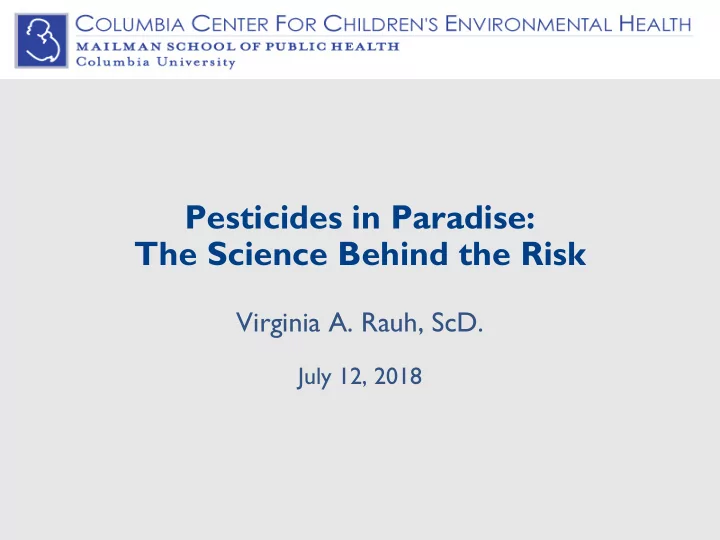

Pesticides in Paradise: The Science Behind the Risk Virginia A. Rauh, ScD. July 12, 2018
Why worry about the effects of pesticides on human health? 5000 new chemicals/year; at least 25% are neurotoxic High vulnerability of the developing brain Some widely used pesticides (organophosphates) were developed as nerve gas, specifically designed to attack the mammalian central nervous system In June 2000-2001 EPA banned indoor residential use Despite these restrictions, CPF remains one of the most heavily used insecticides world-wide The EPA indoor residential use ban was highly effective
Chlorpyrifos levels in personal air and blood declined after EPA ban ( Columbia Center for Children’s Environmental Health; Whyatt et al., EHP, 2009) Personal air (ng/m 3 , n=621) Maternal plasma (pg/gm, n=424) 8 4 0 Chlorpyrifos Cord plasma (pg/gm, n=395) 1999 2000 2001 2002 2003 2004 2005 2006
Convergence of Observational Evidence All 3 papers reported significant 7 year cognitive deficits on WISC subscales associated with prenatal organophosphate insecticide exposure The studies used three different populations: two urban, one rural/agricultural The studies used different biomarkers of exposure: one used measure of the compound in blood; two used urinary metabolites
Brain Imaging Results: Anomalies in Morphology of the Cerebral Surface • Overall brain size did not differ significantly across exposure groups, unadjusted or adjusted for age, sex, and height; • There were volumetric differences and deformations in specific brain regions, with or without correction for overall brain size; • Enlargements at the cerebral surface derived primarily from enlarged underlying white matter. Rauh et al., PNAS, 2012
Effects of Pesticide Exposure on Regional Brain Volumes and Associated Cognitive Processes PoCG Attention/Receptive Attention/Receptive Language Language right lateral side left lateral side Executive Executive Functions Functions Reward and Emotion right middle left middle Rauh and Peterson, PNAS, 201 2 Rauh et al., PNAS, 2012
Brain Imaging Results: CPF Association with Cortical Thinning • CPF associated with reduced thickness of dorsal parietal and frontal cortices • Cortical thinning may be associated with increase risk of cognitive, behavioral and mental health symptom severity
Typical child’s brain showing locations (pink color) where pesticide exposure is associated with cortical thinning Anterior Posterior Rauh et al., PNAS, 2012 Rauh and Peterson, PNAS, 201 2
To summarize the MRI findings: Prenatal exposure, even at low levels consistent with standard usage and comparable to current agricultural exposures, is significantly associated with structural changes in the developing brain, that persist into middle childhood, and may be related to longer term neuro- psychological and motor problems.
Recommend
More recommend